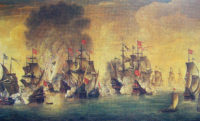 Earlier this summer, the remains of a shipwreck were discovered during renovation of a quay on the Skeppsholmen islet in central Stockholm. Stockholm is no stranger to shipwrecks underneath its feet. Like Manhattan, San Francisco and other major port cities, large parts of it were constructed over the rubble of discarded ships. Archaeologists from the Stockholm Maritime Museum were overseeing the work and so were on site when the wreck first emerged and it was quickly clear to them that this ship was much older than anything they had expected to find in the area.
Earlier this summer, the remains of a shipwreck were discovered during renovation of a quay on the Skeppsholmen islet in central Stockholm. Stockholm is no stranger to shipwrecks underneath its feet. Like Manhattan, San Francisco and other major port cities, large parts of it were constructed over the rubble of discarded ships. Archaeologists from the Stockholm Maritime Museum were overseeing the work and so were on site when the wreck first emerged and it was quickly clear to them that this ship was much older than anything they had expected to find in the area.
“We were really surprised, because we have some old maps that show some wrecks from the early 1800s, and it seems like the older wrecks don’t show up on the map. There were no indications of this wreck on the maps,” [marine archaeologist Jim Hansson] said, adding the remains uncovered include a section of the ship two metres up from the keel and parts of the transom.
“It was really well preserved. It is only to the first deck level, but you can still see the cut marks from the axes on the timber, for example. It’s been really nice to excavate the parts.”
 Dendrochronological analysis of wood samples from the shipwreck found that the oak timbers were cut in the winters of 1612/3 and 1613/4 from trees in Sweden. The principle of Swedish shipbuilding in the early 17th century held that wood should be used within two years of cutting, so most of the ship was probably built between 1612 and 1614 with bursts of activity through 1616. The team searched through the naval archives for major warships that were built at that time. Only four warships were found on the lists made then. Two of them were too small, the third sank in a storm at sea leaving one likely identification: the Scepter, the largest of them all.
Dendrochronological analysis of wood samples from the shipwreck found that the oak timbers were cut in the winters of 1612/3 and 1613/4 from trees in Sweden. The principle of Swedish shipbuilding in the early 17th century held that wood should be used within two years of cutting, so most of the ship was probably built between 1612 and 1614 with bursts of activity through 1616. The team searched through the naval archives for major warships that were built at that time. Only four warships were found on the lists made then. Two of them were too small, the third sank in a storm at sea leaving one likely identification: the Scepter, the largest of them all.
The Scepter was built by Isbrand Johansson, the Dutch-born master shipwright at Stockholm’s Royal shipyard, starting in late 1612, early 1613. She entered the lists in 1615 but was only fully completed and ready for action in 1617. Displacing 800 tons and armed with 36 guns, it was one of the flagships of young King Gustavus Adolphus’ fleet. In 1621, the Scepter carried that same king on a mission of conquest to Riga, then part of the Polish–Lithuanian Commonwealth. They got it as far as Estonia before a storm forced them to stop. The king disembarked and made his way to Riga overland. The surviving ships of the 148 that had set out for Riga tried again only to meet another brutal storm. The fleet, including the Scepter, finally did make it to Riga, although Scepter ran aground once she got there and the whole fleet had to wait for the crew to extricate her.
 After a long and distinguished career, the Scepter was retired in 1639 and sent to a farm in the country with lots of other ships to play with in a big crystalline lake. Naw, jk, they scuttled her on the coast of Skeppsholmen so her woodsy skeleton could be part of the foundation of a new shipyard being built on the island.
After a long and distinguished career, the Scepter was retired in 1639 and sent to a farm in the country with lots of other ships to play with in a big crystalline lake. Naw, jk, they scuttled her on the coast of Skeppsholmen so her woodsy skeleton could be part of the foundation of a new shipyard being built on the island.
The king who ordered her construction when he was a teenager and caught a ride to nowhere on her a few years later, was a brilliant military commander whose success in warfare on sea and land during the Thirty Years’ War made Sweden one of the great powers of Europe. From his ascension to the throne as Gustav II Adolf in 1611 two months shy of his 17th birthday until his early death in 1632, Gustavus fought constantly, first to keep his throne and then to expand its territories and powers exponentially. He inherited wars against three foreign powers and was beset by enemies/family members who thought a boy king made an easy target.
 They were wrong. Little Gustav turned out to be really good at fighting. (When will we learn the lessons of Lyanna Mormont of Bear Island?) His innovative approach combined modern technology (artillery), cavalry and infantry to work together seamlessly. All of his troops received extensive cross-training and were not saddled with all the hierarchical obsessions about which branch of the armed services were superior to others, cavalrymen being higher-up on the socio-military scale than infantry, etc. Gustavus did away with those entrenched inequities kept other nations’ militaries splintered in function and fractious in disposition. Every branch was treated equitably with full financial support from the king’s efficient and, most importantly, solvent administration.
They were wrong. Little Gustav turned out to be really good at fighting. (When will we learn the lessons of Lyanna Mormont of Bear Island?) His innovative approach combined modern technology (artillery), cavalry and infantry to work together seamlessly. All of his troops received extensive cross-training and were not saddled with all the hierarchical obsessions about which branch of the armed services were superior to others, cavalrymen being higher-up on the socio-military scale than infantry, etc. Gustavus did away with those entrenched inequities kept other nations’ militaries splintered in function and fractious in disposition. Every branch was treated equitably with full financial support from the king’s efficient and, most importantly, solvent administration.
Because of his forward-thinking integration of resources human, animal and technological and his gift for logistics, Gustavus Adolphus has been called the Father of Modern Warfare. After he died leading a cavalry charge at The Battle of Lützen on November 6, 1632, the Swedish Estates of the Realm declared that King Gustavus Adolphus would hereby be known as Gustavus Adolphus Magnus, Gustav Adolf the Great. That remains his official name in Sweden. He is the only king of Sweden to be granted this honorific.
It was Gustavus Aldophus who created the modern Swedish navy, taking it from the small Royal Fleet his grandfather King Gustav Vasa had started with ships he bought from the powerful Hanseatic city of Lübeck into a naval force of state-of-the-art warships. Gustavus started from scratch, building and expanding shipbuilding facilities that could supply new vessels at a brisk pace. He also started young, still effectively under regency, ordering new, heavily armed warships so he had a chance against in all those wars Sweden had been embroiled in while he was still in diapers. Ten years after the Scepter was launched, Gustavus launched an even larger beauty queen of a ship that also wound up wrecked. This one wasn’t wrecked deliberately — it was too top-heavy and just toppled over like a real life Barbie doll would — and good thing too because then we would have been denied the misty fantasy dreamship that is the Vasa.
“It’s a really important find because the ship is from the generation before Vasa, so we can see the technical building methods that were used, and it can help us understand what went wrong with the Vasa as well,” said Hansson[.]
The poor Scepter doesn’t rate the kind of huge-budget, multi-decade commitment that resurrected the Vasa. It isn’t intact, obviously, and there are no plans to raise it. Researchers have done some 3D imaging of the wreck in situ, fully documented it and taken samples. She’s staying where she is. Construction continues at the site, still overseen by Stockholm Maritime Museum archaeologists who are hoping more of the ship, or artifacts therefrom, may be discovered.
Do you have any additional information on Isbrand Johannson, the ship builder of the Scepter?